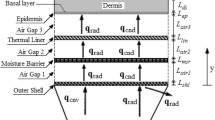Abstract
Thermal protection of firefighter protective clothing is greatly influenced by the air gap entrapped and moisture in clothing. In this paper, the effects of air gap size and position on thermal protective performance exposed to 84 kW/m2 heat source were investigated. Water was also added to thermal liner to understand the effect of air gap coupled with moisture on thermal protection. It was indicated that the TPP of fabrics system increased with the air gap size. The air gap position also greatly influenced the heat transfer during exposure to flash fire. Moisture added weakened the positive effect of air gap size when the air gap exists far from heat source, and almost eliminated the favorable effect of air gap position. However, when there is no air gap or small air gap between outer shell fabric and moisture barrier, moisture increased the thermal protection performance of multilayer fabrics system. The results obtained suggested that certain air gap entrapped in fabrics system and clothing microclimate could improve thermal protection, and the complicated effect of moisture should also be considered.
Similar content being viewed by others
References
D. Barr, W. Gregson, and T. Reilly, Appl. Ergon., 41, 161 (2010).
G. W. Song, Ph.D. Dissertation, North Carolina State University, North Carolina, 2002.
D. A. Torvi, J. D. Dale, and B. Faulkner, J. Fire Prot. Eng., 10, 1 (1999).
C. M. J. Sawcyn, MS Thesis, University of Saskatchewan, Saskatoon, 2003.
F. L. Zhu and W. Y. Zhang, J. Fire Sci., 24, 465 (2006).
G. W. Song, J. Ind. Text., 36, 193 (2007).
T. Mah and G. W. Song, Text. Res. J., 80, 1317 (2010).
T. Mah and G. W. Song, Text. Res. J., 80, 1473 (2010).
Annual Report on Evaluating the Effect of Moisture on the Thermal Protective Performance of Firefighter Protective Clothing in Low Level Heat Exposure, TPACC-report, p.11.
C. M. J. Sawcyn and D. A. Torvi, Text. Res. J., 79, 632 (2009).
R. M. Rossi and T. Zimmerli, “Performance of Protective Clothing: Fifth Volume, ASTM STP 1237” (James S. Johnson and S. Z. Mansdorf Eds.), American Society for Testing and Materials, Philadelphia, 1995.
H. Mäkinen, J. Smolander, and H. Vuorinen, “Performance of Protective Clothing: Issues and Priorities for the 21st Century”, Second Symposium. (S. Z. Mansdorf, R. Sager, and A. P. Nielsen Eds.), pp.415–421, Philadelphia, PA, 1988.
R. L. Barker, S. C. Guerth, R. V. Grimes, and H. Hamouda, Text. Res. J., 76, 27 (2006).
L. K. Lawson, E. M. Crown, M. Y. Ackerman, and J. D. Dale, JOSE, 10, 227 (2004).
G. W. Song, S. Paskaluk, R. Sati, E. Crown, J. Dale, and M. Ackerman, Text. Res. J., 81, 311 (2010).
Author information
Authors and Affiliations
Corresponding author
Rights and permissions
About this article
Cite this article
Wang, Yy., Lu, Yh., Li, J. et al. Effects of air gap entrapped in multilayer fabrics and moisture on thermal protective performance. Fibers Polym 13, 647–652 (2012). https://doi.org/10.1007/s12221-012-0647-1
Received:
Revised:
Accepted:
Published:
Issue Date:
DOI: https://doi.org/10.1007/s12221-012-0647-1



